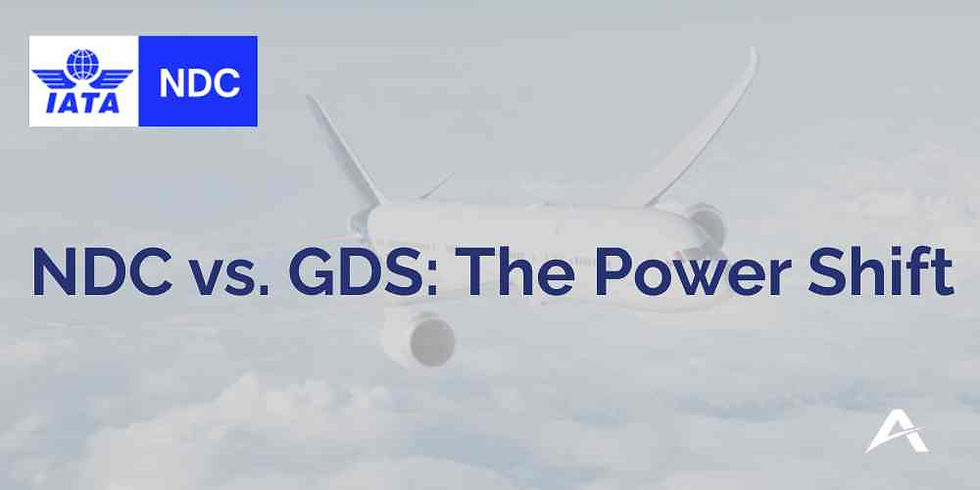The $96 Lesson That Still Matters for Airline NDC
- Shawn Kousha

- Aug 19
- 4 min read
Updated: Sep 15

I’ve been using distribution systems since my first day in a travel agency.
Over the years, I hopped between systems. Amadeus in one office, Sabre or Travelport in another—whichever tech stack the desk required.
From the agency’s perspective, I had no idea how these systems worked in terms of cost. We weren’t paying fees; sometimes, we even earned incentives to book through a particular channel.
The moment it clicked for me came during IATA’s Commercial Airline Foundations course. The real cost to airlines is eye-watering.
The instructor flashed a slide: one PNR, four passengers, four segments. “Guess what the GDS charges the airline for this?” he asked.
We guessed low; the answer was about $96 for that single booking.
I walked out thinking: with charges like that, why wouldn’t airlines build their own distribution systems?
NDC’s Promise vs. the Plumbing
NDC sounded like the answer.
It promised richer retailing, direct control, and relief from 20th-century EDIFACT tolls. Airlines could publish dynamic offers, bundle ancillaries, and own the shelf.
But XML is a language, not a law. Each carrier spoke a slightly different dialect. Behind the layers of retail gloss, the pipes mattered.
Offer systems had to handshake with the PSS. Orders had to reconcile with finance. Refunds had to pass audit.
TMCs needed exchanges, waivers, duty-of-care, and reporting that behaved the same way every day.
Great storefronts still fell over at the servicing counter.
Bottom line: the vision was right; the sequence (governance → servicing → scale) was off.
The Operating System We Underestimated: PNR Logic
If websites are the shop window, the PNR is the operating system.
Revenue management, interline, proration, disruption—most airline biology still runs on PNR/RBD logic.
IATA’s One Order seeks to fold ticket, PNR, and EMD into a single order ID. Elegant on paper; surgical in production.
Change the OS, and you change the airline.
You can ship beautiful shopping in weeks.
You win trust when reissues, refunds, invoices, and reporting are boringly reliable. Partners won’t move volume until that day arrives.
Translation: retail sells the dream; servicing makes it real.
“Personalization” Isn’t a Protocol but a Practice
We hoped NDC would melt rigid booking classes.
In reality, even modern retailers anchor to simple fences and clear price cascades.
The most “dynamic” outcomes come from disciplined catalogs and data loops, not protocol alone.
XML doesn’t substitute for pricing craft and process discipline.
Net effect: protocol helps; practice decides.
Adoption & Spend: The Part No One Puts in a Press Release
Twelve years in, NDC volume is meaningful but modest in global indirect channels.
A good chunk of bookings sits in direct or curated partner pipes.
Industry spend for airlines, TMCs, GDS, and vendors lands in the billions once you tally rewrites and opportunity costs.
The persistent choke point remains post-ticket servicing.
Read that twice: retail moved faster than the warehouse.
Plot Twist: GDS Didn’t Disappear—They Pivoted
Airlines tried to route around tollbooths; the tollbooths became on-ramps.
Amadeus, Sabre, and Travelport reframed as offer/order platforms, wrapping NDC with uptime, tooling, and scale.
Several early NDC leaders now lean on these platforms to make content bookable and serviceable at volume.
Old segment fees give way to API/merchandising economics, but the distribution muscles remain.
Result: not the end of GDS—the end of GDS-as-we-knew-it.
Why Governance Was (and Is) the Quiet Bottleneck
If XML is language, governance is grammar.
Early on, we lacked version locks, SLAs, and common servicing baselines. That birthed a bazaar of “almost compatible” endpoints that broke when anyone blinked.
Evangelism created momentum; neutral engineering authority would have saved millions in rework.
Lesson: standards need referees, not just cheerleaders.
What Actually Works in Airline NDC (Unromantic, Scalable)
Freeze a version. Commit to one NDC version for the year; build test harnesses; honor SLAs.
Service first. Fund exchanges, refunds, and invoices before glossy bundles.
Publish a change calendar. No Friday surprises for partners.
Insist on parity. Coverage, uptime, and disruptions must match EDIFACT before forcing migration.
Automate the ugly. Waiver ingestion, tax recalculations, audit exports, and reconciliation.
Do this, and volume moves without a press release.
Where This Leaves Our Previous Posts
In our earlier April piece, we wrote that GDS-era economics were ending—and the bridge there would be bumpy.
That’s largely what unfolded: surcharges, direct-only content, and strategic returns to GDS aggregation when scale and servicing mattered.
Two truths coexist: pricing power is shifting to airlines, while plumbing power still sits with the integrators who do boring things well.
That isn’t capitulation; it’s sequencing that protects customers while retail evolves. Pragmatism > purity wins this transition.
A Field Guide for 2025 (If You Own the P&L)
Blend channels by design. Use GDS-hosted NDC as scaffolding while direct APIs mature.
Make governance a product. Docs, mocks, sandboxes, and release notes are partner UX.
Measure the right KPIs. Service completion rates, refund latency, disruption recovery—not just “% via NDC.”
Invest in catalogs. Clean product and ancillary definitions beat flashy front ends.
Timebox experiments. Pilot fast, kill faster, and scale only when servicing is dull.
Remember: customer experience fails at the touchpoints no one demos.
What I Tell Teams When the Room Gets Quiet
Start with the $96 moment.
Ask where you’re truly buying freedom by using Airline NDC instead of GDS, channel, content, or customer lifetime value. Spend there first.
Use GDS platforms as scaffolding while you harden your own offer/order core, especially servicing and finance.
Force-rank every feature by its impact on post-ticket outcomes, not homepage glamor. Treat governance as a product: versioning, docs, test harnesses, and SLAs are your UX for partners.
And to the question I asked years ago in that IATA classroom: “Why don’t airlines just build their own pipes?” My answer has matured.
To learn more about Anjuna, please visit: Anjuna Airline Solutions.


